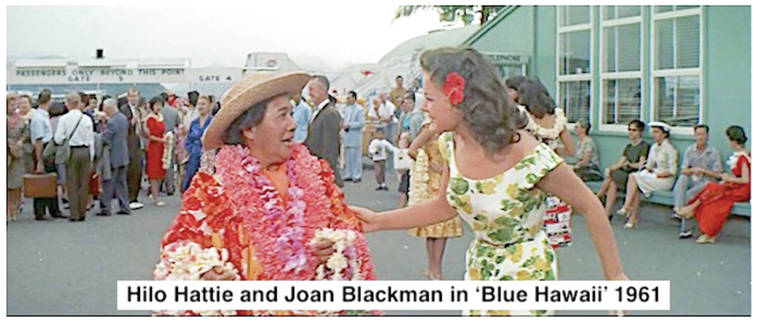With her flashing, mischievous eyes and her trademark costume — a coconut hat and a mu‘umu‘u with a scarf tied low around her hips — Hilo Hattie (1901-1979), the Native Hawaiian school teacher who performed for nearly half a century as a comic hula dancer, singer and actress, was not from Hilo, nor was her real surname Hattie.
With her flashing, mischievous eyes and her trademark costume — a coconut hat and a mu‘umu‘u with a scarf tied low around her hips — Hilo Hattie (1901-1979), the Native Hawaiian school teacher who performed for nearly half a century as a comic hula dancer, singer and actress, was not from Hilo, nor was her real surname Hattie.
The woman who personified the happy Hawaiian tutu wahine was born Clarissa Haili in Honolul, and took her stage name from the 1932 Don McDiarmid Sr.-Johnny Noble song “When Hilo Hattie Does the Hilo Hop,” which became her signature tune. Her married name was Clara Nelson.
Following her graduation from Honolulu’s Territorial Normal School, she taught in elementary schools at ‘Ewa and Waipahu before launching her entertainment career in 1936, mainly at the Royal Hawaiian Hotel with Louise Akeo’s Royal Hawaiian Girls Glee Club.
By 1939, she’d burst upon the Hawaiian entertainment scene with songs such as “When Hilo Hattie Does the Hilo Hop,” “Princess Pupule,” “Whassa Matta You Last Night,” and her second signature song, “The Cockeyed Mayor of Kaunakakai,” which she sang in the 1941 movie “Song of the Islands,” the first of her many films.
During World War II, she performed special shows for servicemen on the way to or from war in the Pacific with bandleader Harry Owens — the composer of “Sweet Leilani” — and his orchestra at the St. Francis Hotel in San Francisco.
Hattie also garnered worldwide acclaim when she joined Webley Edwards on his “Hawai‘i Calls” radio program that ran from 1935 to 1972 and was broadcast to 600 radio stations around the globe, usually from Waikiki’s Moana Hotel.
Later, she was a featured performer at various Waikiki hotels and on the nationally broadcast 1977 Don Ho show, and elsewhere, and made a cameo appearance in the Elvis Presley movie “Blue Hawai‘i” — much of which was filmed at Kaua‘i’s Coco Palms Hotel in 1961.
Hilo Hattie is the brand name of several retail stores operating in Hawai‘i, one of which is located in Lihu‘e.
•••
Hank Soboleski has been a resident of Kauai since the 1960s. Hank’s love of the island and its history has inspired him, in conjunction with The Garden Island Newspaper, to share the island’s history weekly. The collection of these articles can be found here: https://bit.ly/2IfbxL9 and here https://bit.ly/2STw9gi Hank can be reached at hssgms@gmail.com



OMG, we never knew that. I think we even looked up her grave site in the Punch Bowl cemetery the last time we were on the islands….thanks for keeping us Indiana residents up on the island news….great job!!
Aloha!
Did you all know that the wonderful Hilo Hatti had a memorable role in Season 1 (1968) episode of Hawaii Five-0. “Strangers in our own land”. She played Mrs. Kapali, a mother whose son was in trouble and Det. Steve McGarrett vows to try and help her son but is caught between his Civic duties and as a respected figure in the Hawaiian community – all the while observing the rapidly changing landscape of Hawaii in the post-WW II era. Having achieved statehood in 1959 followed by a mainland fascination of everything Hawiian aka “Hawaiiana” in the early 1960s, real estate developments drastically transformed Hawaiian farms, sugar-cane fields and the natural beauty into what we see today. The writers of Hawaii Five-O should be given more credit for their ability to accurately incorporate events effecting native Hawaiian and Hawaiian culture at that time into the show’s scripts. If you watch al of the original series you will see parallels between the past and present events affecting Hawaiian culture and its place in the ever-changing modern world.
A Hui Hou,
Louie